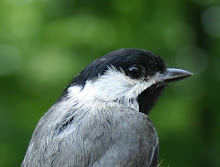Holy crap. Has it really been 2 months since I've last posted an entry? Wow.
Well, I haven't fallen off the face of the earth. I've been following my favorite blogs and have even thought about posting but I've been a bit...preoccupied.
The Bird Sanctuary is hosting the
Inland Bird Banding Association conference this year and yours truly is presenting a paper. As most of you know, I have spent the last 2 summers studying the songbird populations on a piece of restored prairie(Entries
here and
here and
here). I narrowed my focus (because there are a few things I'm studying) on the nest boxes on the prairie and whether or not prescribed burns affect the predation rate on the nest boxes. Eurasian Tree Sparrows were the birds predominantly using the boxes
I began writing the paper in August, right around the time I stopped blogging as a matter of fact. Academic pursuits bring out the worst of my neurotic tendencies. The paper started easily enough. I breezed through the introduction and procedure portions of the paper but the difficulties began with the results section. I had to review and interpret 2 years worth of data: numbers of eggs that hatched, chicks that survived to leave the nest box, predation numbers. So...many...numbers. The panic began to trickle in but it was quelled with a call to Shark Girl (who is now in Grad school I might add :) )
"There's so many fricking numbers!" I exclaimed during our first of at least 3 calls
"Indeed. A lot to interpret." She agreed.
I know that first call lasted at least 3 hours. I'm not exaggerating. But we did get a lot done.
The hill of difficulty progressively got steeper over the weeks, as did my level of anxiety. What was I going to do with all of these percentages? How did I make sense of and organize the numbers? The words "T-test" began to float around and I panicked. T-test? I didn't even remember how to do a T-test. Then my self esteem tanked. What kind of field biologist was I that I couldn't do a T-test, much less think of running one? What the hell was I doing? I felt like an impostor. I had no business preparing a presentation! Danno's dad came to my rescue that time and helped me break down my numbers into a more manageable size. He also walked me through some simple calculations that could be performed on Excel. Heck, he almost made it look like fun!
An odd combination of excitement, panic and low self esteem formed and filtered into my thoughts, sleep and stomach. I often fell asleep only to wake up with thoughts about the numbers, what they meant and wondering how to put them all together. Eating resulted in heartburn and looking at my data on Excel only drove the panic.
It wasn't long before Beetle Guru and Shark Girl became my Sparrow Champions. They listened to my thoughts and ideas on the paper, critiqued my paper and researched potential stastitical tests that could be run on my data. They also offered a great deal of emotional support. They became common recipients to the "I can't do this I give up" panic, (received either through email or texting before the subsequent phone call) They told me I was doing Graduate level work without the help of a professor or a university.
I LOVE field biology but the math really does turn the anxiety up for me. Honestly, it's the main reason I won't touch graduate school with a 10 foot pole. I'm not sure I could pass any population statistics or other class devoted to interpreting ecology-oriented numbers. It amazes me the number of people (like Beetle Guru and Shark Girl) who believe that I can accomplish the feat of Grad School.
After 2 agonizing months, the paper is finished and the presentation is ready. I'm happy it's finished and I'm already wiggling in anticpation of beginning my work again in the spring. It's funny how the paper took a life of its own and how much I learned in the process. I learned a different way or two how to interpret data, improved my scientific writing skills and discovered there are a few causes that need to be ruled out in terms of predation for next summer. But the biggest thing I learned is that it's ok to seek help and obtaining that help doesn't mean I'm no less intelligent
My next goal is to secure funding for next year's research. I still need to write another report for the mistnetting and bird census results. Put your seat belts on ladies and gentlemen. We may be in for a bumpy ride.







